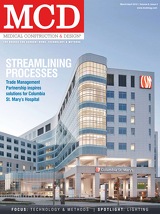Medical Construction & Design (MCD) is the industry's leading source for news and information and reaches all disciplines involved in the healthcare construction and design process. To view more past issues go to: http://mcdmag.epubxpress.com
Page 22 of 70
SPOTLIGHT LIGHTING
When color changing is part of a program, LEDs offer the most fl exibility with lowest operational cost.
A look at LEDs
Creating a high-quality visual healthcare environment
By Denise Fong
ity ambience. At the same time, the pressure to keep capital costs and maintenance costs down is ever present. To meet energy codes in the public spaces, compact fl uorescent fi xtures have been the work- horse of the industry for many years. While these fi xtures meet energy demands and, to some degree, maintenance and budgetary concerns, they have never been satisfac- tory in terms of creating an incandescent-like atmosphere. It is diffi cult (and expensive) to dim the lamps and, at best, have a 10,000-12,000-hour life. If controlled on occu-
T
here is a strong desire in today's healthcare design to create a facility with a hospital-
pancy sensors, the life will be much lower. These lamps also contain mercury and must be carefully disposed of, and it's not unusual for them to break during the re-lamping process, which creates a potentially hazardous situation. LEDs are on everyone's mind, but are they really
Outlining the "grass blades" with LEDs made them visible in the large daylit atrium while being mindful of maintenance concerns and energy use.
18 Medical Construction & Design | March/April 2012
ready for widespread use and adoption? The distinction fi rst must be made between LED replacement lamps used in fi xtures designed for incandes- cent lamps and LED fi xtures, designed from the ground up as an LED product with the en- gineering that goes with it. LED replacement lamps are most readily available in PAR30, PAR38 and "A" lamp (standard household-shape) styles. The technology is changing so rapidly it is impossible to say that a specifi c brand is best or that a particular LED is compa- rable to an incandescent lamp. It is best to test and compare color and output to the lamp it is replacing. If a local utility company is offering rebates for usage, there might be a list of acceptable replacements. Beware, however, utility com- panies are primarily interested in energy savings and may not be as sensitive to color quality or beam distribution. Individual analysis is essential.
Shedding light on Zhaga Developing LED fi xtures has been much like the taming of the Wild West. It has been ev- ery manufacturer for himself. But some initial cooperation will eventually lead to depend- able, predictable outcomes. The organization to watch is Zhaga. It is defi ned as "an industry-wide cooperation aimed at the development of standard specifi cations for the interfaces of LED light en- gines." The organization fur- ther defi nes an LED engine as "an LED module with defi ned interfaces that do not depend on the type of LED technology used inside the light engine." The goal of Zhaga is to foster interchangeabil- ity of components between manufacturers. As technol- ogy evolves, owners are not stuck with equipment that has become obsolete. This will foster rapid adoption and continue to encourage future development of more effi cient
www.mcdmag.com
PHOTOS: BENJAMIN BENSCHNEIDER PHOTOGRAPHY
